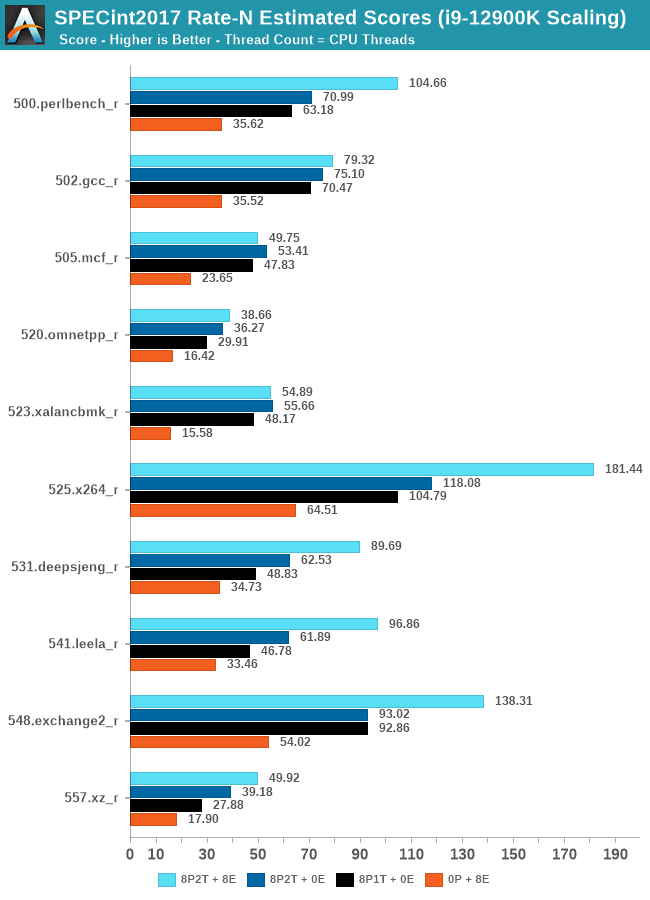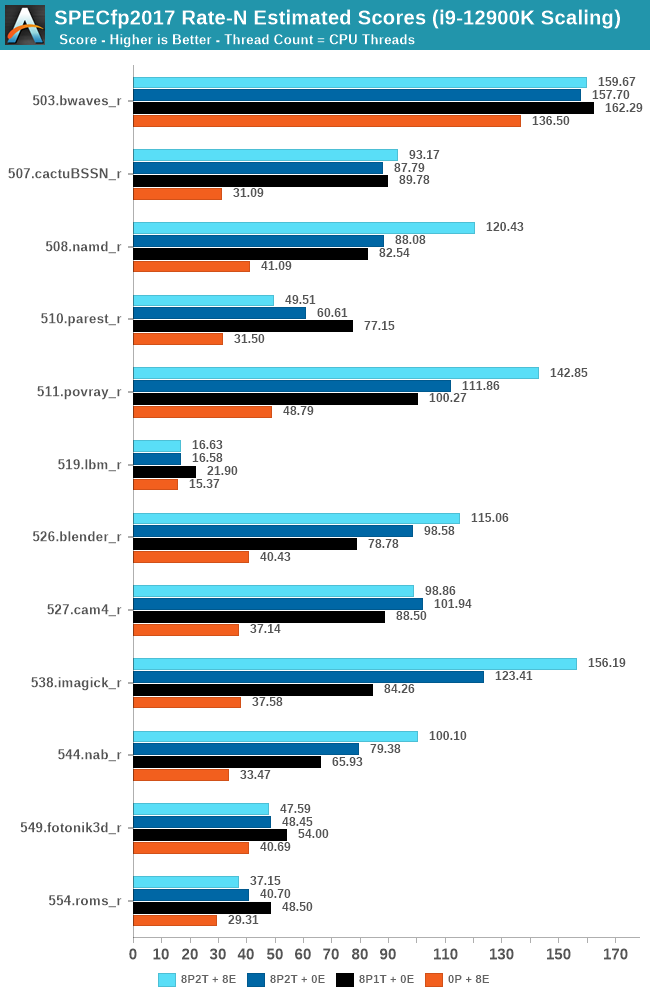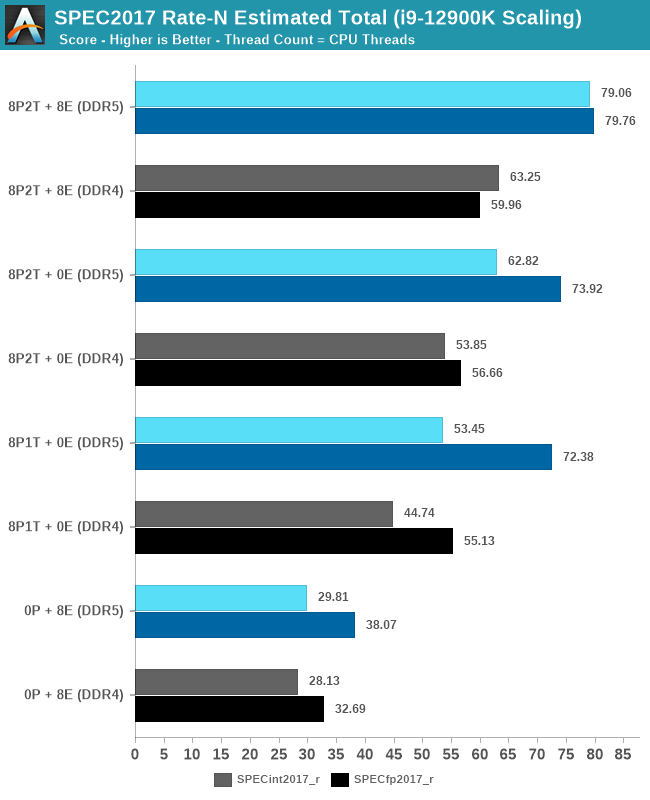The Intel 12th Gen Core i9-12900K Review: Hybrid Performance Brings Hybrid Complexity
by Dr. Ian Cutress & Andrei Frumusanu on November 4, 2021 9:00 AM ESTCPU Tests: SPEC MT Performance - P and E-Core Scaling
Update Nov 6th:
We’ve finished our MT breakdown for the platform, investigating the various combination of cores and memory configurations for Alder Lake and the i9-12900K. We're posting the detailed scores for the DDR5 results, following up the aggregate results for DDR4 as well.
The results here solely cover the i9-12900K and various combinations of MT performance, such as 8 E-cores, 8 P-cores with 1T as well as 2T, and the full 24T 8P2T+8E scenario. The results here were done on Linux due to easier way to set affinities to the various cores, and they’re not completely comparable to the WSL results on the previous page, however should be within small margins of error for most tests.

In the integer suite, the E-cores are quite powerful, reaching scores of around 50% of the 8P2T results, or more.
Many of the more core-bound workloads appear to very much enjoy just having more cores added to the suite, and these are also the workloads that have the largest gains in terms of gaining performance when we add 8 E-cores on top of the 8P2T results.
Workloads that are more cache-heavy, or rely on memory bandwidth, both shared resources on the chip, don’t scale too well at the top-end of things when adding the 8 E-cores. Most surprising to me was the 502.gcc_r result which barely saw any improvement with the added 8 E-cores.
More memory-bound workloads such as 520.omnetpp or 505.mcf are not surprising to see them not scale with the added E-cores – mcf even seeing a performance regression as the added cores mean more memory contention on the L3 and memory controllers.

In the FP suite, the E-cores more clearly showcase a lower % of performance relative to the P-cores, and this makes sense given their design. Only few more compute-bound tests, such as 508.namd, 511.povray, or 538.imagick see larger contributions of the E-cores when they’re added in on top of the P-cores.
The FP suite also has a lot more memory-hungry workload. When it comes to DRAM bandwidth, having either E-cores or P-cores doesn’t matter much for the workload, as it’s the memory which is bottlenecked. Here, the E-cores are able to achieve extremely large performance figures compared to the P-cores. 503.bwaves and 519.lbm for example are pure DRAM bandwidth limited, and using the E-cores in MT scenarios allows for similar performance to the P-cores, however at only 35-40W package power, versus 110-125W for the P-cores result set.
Some of these workloads also see regressions in performance when adding in more cores or threads, as it just means more memory traffic contention on the chip, such as seen in the 8P2T+8E, 8P2T regressions over the 8P1T results.

What’s most interesting here is the scaling of performance and the attribution between the P-cores and the E-cores. Focusing on the DDR5 set, the 8 E-cores are able to provide around 52-55% of the performance of 8 P-cores without SMT, and 47-51% of the P-cores with SMT. At first glance this could be argued that the 8P+8E setup can be somewhat similar to a 12P setup in MT performance, however the combined performance of both clusters only raises the MT scores by respectively 25% in the integer suite, and 5% in the FP suite, as we are hitting near package power limits with just 8P2T, and there’s diminishing returns on performance given the shared L3. What the E-cores do seem to allow the system is to allows to reduce every-day average power usage and increase the efficiency of the socket, as less P-cores need to be active at any one time.










474 Comments
View All Comments
Wrs - Saturday, November 6, 2021 - link
Nah, they just weren't that competitive. Athlon64 was decent (lot of credit to Jim Keller) but didn't let AMD take massive advantage of Intel's weakness during the Pentium 4 era because AMD fabs were capacity limited. Once Conroe came out mid 2006 the margins dried up rapidly and AMD had no good response and suffered a talent exodus. It's true Intel made it worse with exclusivity bonuses, but I think AMD's spiral toward selling their fabs would have happened anyway. No way they were going to catch up with tick-tock and Intel's wallet.GeoffreyA - Monday, November 8, 2021 - link
I've always felt the K10 wasn't aggressive enough, owing to AMD not having factored Conroe into their equations when K10 was designed. Then, like startled folk, they tried to take back the lead by a drastic departure in the form of Bulldozer; and that, as we know, sank them into the ditch. Nonetheless, I'm glad they went through the pain of Bulldozer: Zen wouldn't have been as good otherwise.mode_13h - Tuesday, November 9, 2021 - link
> FX series was as bad as it was for a couple of reasonsI thought I also heard they switched from full-custom layout to ASIC flow (maybe for the sake of APUs?). If so, that definitely left some performance on the table.
bunnyfubbles - Thursday, November 4, 2021 - link
3D v-cache will be out before Zen 4 and should help close the gap if not regain the overall lead on the high end. The problem for AMD is the competition below the i9 vs R9 realm, where the E cores really pull more than their weight and help the i9 compete with the R9s in multi, but for the i5s and i7s vs their R5 and R7 counterparts, its even-Steven with performance cores, then you have the E cores as the trump card.MDD1963 - Thursday, November 4, 2021 - link
If AMD gains an averge of ~10% in gaming FPS with the 3D cache onslaught, that should put them right back near the top...certainly much closer to the 12900K....geoxile - Thursday, November 4, 2021 - link
15% on average. 25% at the highest. Intel really should have offered a 16 P-core die for desktop smdh, classic intel blunderSpunjji - Friday, November 5, 2021 - link
That would be a hell of a large die and necessitate a total redesign of the on-chip fabric. I don't think it would really make any sense at all.RSAUser - Monday, November 8, 2021 - link
12900K is already huge, each performance core is the size of about 4 E cores, going 16C P-Core would probably mean a 70% die size increase, and then you run into core to core communication issues, AMD got around it with infinity fabric but that's why you have the higher latency access between cores in different core complexes and Intel gives a more consistent access time on higher end products. Intel's current cores are mosly ringbus, so travel from one core to the next, getting to 16 doesn't scale well, they used a mesh topology in some Skylake CPU's, that latency was too high and hampered performance badly, you'd run into that same issue with 16C.That's without checking into yield, getting 16C on one wafer that are all perfectly clocking high is going to be a very, very rare chip; AMD gets around it using the core complexes (CX) of 4 cores each, together into a CCD (core chiplet die) and then in Zen 3 (5000 series) is supposedly 8C CCX, which makes rare chips 8C if full ccx works well, else 6C if 2 can't make it turns into a 5600X.
StevoLincolnite - Friday, November 5, 2021 - link
AMD has an answer before Zen 4.And that is Zen 3 with V-Cache.
Spunjji - Friday, November 5, 2021 - link
"This is their Zen 1 moment"Indeed!
"at a lower price"
Not really, if you take platform into account (and you have to!)
"Zen 4 isnt even competing with Alder Lake, Raptor Lake is rumored to be out before Zen 4"
Potentially, but Zen 4 is a bigger jump from Zen 3 than Raptor is predicted to be from Alder. Raptor will have more E cores but it's on the same process, so it's likely to offer better perf/watt in multithreading but unlikely to increase overall performance substantially (unless they allow maximum power draw to increase).
"AMD has really screwed up with their launch cycle"
Not really? They're still competitive in both price/performance (accounting for platform cost) and perf/watt. Zen 3D should shore up that position well enough.
"Intel is truly back"
Yup!